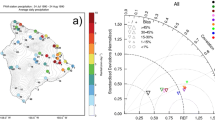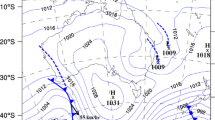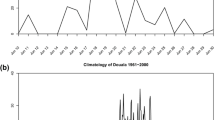Abstract
In this paper, a nonhydrostatic Weather Research and Forecasting (WRF) model has been used to simulate the extreme precipitation event of 25 November 2009, over Jeddah, Saudi Arabia. The model is integrated in three nested (27, 9, and 3 km) domains with the initial and boundary forcing derived from the NCEP reanalysis datasets. As a control experiment, the model integrated for 48 h initiated at 0000 UTC on 24 November 2009. The simulated rainfall in the control experiment depicts in well agreement with Tropical Rainfall Measurement Mission rainfall estimates in terms of intensity as well as spatio-temporal distribution. Results indicate that a strong low-level (850 hPa) wind over Jeddah and surrounding regions enhanced the moisture and temperature gradient and created a conditionally unstable atmosphere that favored the development of the mesoscale system. The influences of topography and heat exchange process in the atmosphere were investigated on the development of extreme precipitation event; two sensitivity experiments are carried out: one without topography and another without exchange of surface heating to the atmosphere. The results depict that both surface heating and topography played crucial role in determining the spatial distribution and intensity of the extreme rainfall over Jeddah. The topography favored enhanced uplift motion that further strengthened the low-level jet and hence the rainfall over Jeddah and adjacent areas. On the other hand, the absence of surface heating considerably reduced the simulated rainfall by 30% as compared to the observations.











Similar content being viewed by others
References
Abdullah MA, Al-Mazroui MA (1998) Climatological study of the southwestern region of Saudi Arabia, rain analysis. Clim Res 9:213–223
Almazroui M (2011) Sensitivity of a regional climate model on the simulation of high intensity rainfall events over the Arabian Peninsula and around Jeddah (Saudi Arabia). Theor and Appl Climatol 104:261–276
Almazroui M (2013) Simulation of present and future climate of Saudi Arabia using a regional climate model (PRECIS). Int J Climatol 33:2247–2259
Almazroui M, Islam MN, Athar H, Jones PD, Rahman MA (2012) Recent climate change in the Arabian Peninsula: seasonal rainfall and temperature climatology of Saudi Arabia for 1979–2009. Atmos Res 11:29–45
Buzzi A, Tartaglione N, Malguzzi P (1998) Numerical simulations of the 1994 Piedmont flood: role of orography and moist processes. Mon Wea Rev 126:2369–2383
Charles AD (1993) Scientific approaches for very short-range forecasting of severe convective storms in the United States of America. International Workshop on Observation/Forecasting of Mesoscale Weather and Technology of Reduction of Relevant Disasters, Tokyo, Japan, 22–26 February 1993, 181–188
Das S, Sarkar A, Das MK, Rahman MM, Islam MN (2015) Composite characteristics of Nor’westers based on observations and simulations. Atmos Res 158:158–178
Dudhia J (1989) Numerical study of convection observed during the winter monsoon experiment using a mesoscale two dimensional model. J Atmos Sci 46:3077–3107
El-Fandy MG (1948) The effect of the Sudan monsoon low on the development of thundery conditions in Egypt, Palestine and Syria. Q J R Meteorol Soc 74:31–38
Fritsch JM, Maddox RA (1981) Convectively driven mesoscale weather systems aloft. Part I: Observations J Appl Meteor 20:9–19
Grell GA, Devenyi D, (2002) A generalized approach to parameterizing convection combining ensemble and data assimilation techniques. Geophys Res Lett 29(14), doi:10.1029/2002GL015311
Haggag M, El-Badry H (2013) Mesoscale numerical study of quasi-stationary convective system over Jeddah in November 2009. Atmos Clim Sci 3:73–86
Hong SY, Noh Y, Dudhia J (2006) A new vertical diffusion package with an explicit treatment of entrainment processes. Mon Wea Rev 134:2318–2341
Hosny H, Almazroui M (2015) Rainfall: features and variations over Saudi Arabia, a review. Climate 3:578–626
Kahana R, Ziv B, Enzel Y, Dayan U (2002) Synoptic climatology of major floods in the Negev desert, Israel. Int J Climatol 22(7):867–882
Krichak SO, Alpert P (1998) Role of large scale moist dynamics in November 1-5, 1994, hazardous Mediterranean weather. J Geophys Res 113:453–468
Maddox RA (1980) Mesoscale convective complexes. Bull Am Meteorol Soc 61:1374–1387
Maddox RA, Perkey DJ, Fritsch JM (1981) Evolution of upper tropospheric features during the development of a mesoscale convective complex. J Atmos Sci 38:1664–1674
Martín A, Romero RV, De Luque A, Alonso S, Rigo T, Llasat MC (2007) Sensitivities of a flash flood event over Catalonia: a numerical analysis. Mon Wea Rev 135:651–669
McNulty RP (1978) On upper tropospheric kinematics and severe weather occurrence. Mon Wea Rev 106:662–672
Michalakes J, Dudhia J, Gill DO, Henderson T, Klemp J, Skamarock W, Wang W (2005) The weather research and forecast model: software architecture and performance. In: 11th workshop on high performance computing in meteorology. World Scientific, pp 156–168
Mlawer EJ, Taubman SJ, Brown PD, Iacono MJ, Clough SA (1997) Radiative transfer for inhomogeneous atmosphere: RRTM, a validated correlated model for long wave. J Geophy Res 102(D14):16663–16682
Noah Y, Cheon WG, Hong SY, Raasch S (2003) Improvement of the K-profile model for the planetary boundary layer based on large eddy simulation data. Bound-Layer Meteor 107:401–427
Raju PVS, Potty J, Mohanty UC (2012) Simulations of tropical cyclone Nargis over Bay of Bengal using RIMES operational system. Pure and Appl Geophy 169(10):1909–1920
Sharon D, Kutiel H (1986) The distribution of rainfall intensity in Israel, its regional and seasonal variations and its climatological evaluation. J Clim 6:277–291
Skamarock WC, Klemp JB, Dudhia J, Gill DO, Barker DM, Wang W, Powers JG (2005). A description of the advanced research WRF Version 2. NCAR Technical Note TN-468 + ST, p. 88
Uccellini LW, Johnson DR (1979) The coupling of upper and lower tropospheric jet streaks and implications for the development of severe convective storms. Mon Wea Rev 107:682–703
Weiss SJ, Kain JS, Levit JJ, Baldwin ME, Bright DR (2004) Examination of several different versions of the Weather Research and Forecasting (WRF) model for the prediction of severe convective weather: The SPC/NSSL Spring Program 2004. Preprints, 22nd Conf on Severe Local Storms, Hyannis. Amer Meteor Soc CD-ROM, 17.1
Whitney LF Jr (1977) Relationship of the subtropical jet stream to severe local storms. Mon Wea Rev 105:398–412
Acknowledgements
The authors sincerely acknowledge NCEP for availability of the global reanalysis fields and NOAA for the TRMM rainfall data through their websites. The authors also express thanks to the reviewers for their valuable comments/suggestion for further improving the quality of the manuscript. Computation for the work described in this paper was performed using the Aziz Supercomputer at the King Abdulaziz University’s High Performance Computing Center, Jeddah, Saudi Arabia.
Author information
Authors and Affiliations
Corresponding author
Rights and permissions
About this article
Cite this article
Almazroui, M., Raju, P.V.S., Yusef, A. et al. Simulation of extreme rainfall event of November 2009 over Jeddah, Saudi Arabia: the explicit role of topography and surface heating. Theor Appl Climatol 132, 89–101 (2018). https://doi.org/10.1007/s00704-017-2080-2
Received:
Accepted:
Published:
Issue Date:
DOI: https://doi.org/10.1007/s00704-017-2080-2




